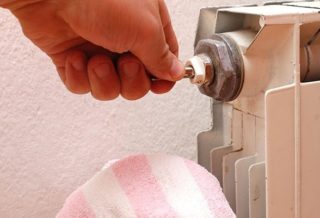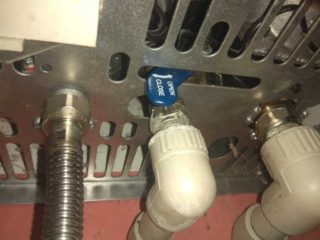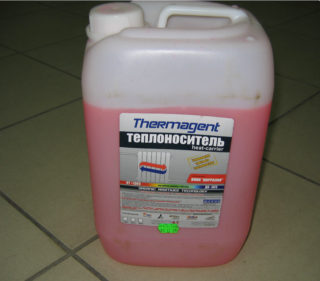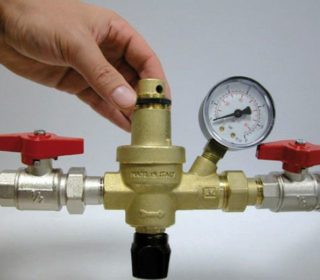The heating circuit in an apartment building or private house runs on water or other liquids with improved characteristics. When installing a new system, the initial filling of the coolant is carried out by specialists. They check for leaks, correct connection and operation of equipment. Subsequent filling of the liquid can be done independently. To do this, you must comply with all conditions for the system to function properly.
Open heating system
There are two types of heating systems - open and closed. They work on a different principle, water is poured into them in their own way. With open heating, the water in the circuit does not circulate under pressure, but naturally. At the upper point is an expansion tank in which the heat carrier is in contact with air. Excess liquid, which expands when heated, also gets into the air, as well as air from the system. Water is poured into this tank.
Algorithm for pouring water into an open heating system:
- Removal from a tank of a cover.
- Pouring water into the tank. This can be done with a hose or bucket. The coolant level can be determined by a special indicator on the device body.
- Excess liquid is discharged through a drain pipe, which is conducted to the sewer.
The coolant should be filled gradually in small portions so that air bubbles exit. When the remaining fluid no longer merges into the pipe, the system is full. It remains only to lower the remaining air from the radiator by opening the Maevsky cranes. Pre-installed under them capacity. When water flows into it, the tap must be closed. After the descent, the necessary volume must be poured into the tank.
After completion of work, you can turn on the boiler for heating the house in winter.
Closed heating system
In systems of this kind, the liquid does not interact with air outside the heating circuit, it circulates through the pump. The design has an expansion tank with a membrane. It is a sealed container, which is divided into two parts using a rubber partition. In the lower compartment is the coolant, and in the upper - air under a constant pressure of 1.5 atmospheres.
Work on pouring water is best done together. One person monitors the descent of air from the pipes, and the other adds coolant. If it is not possible to work together, the liquid is poured gradually under a small pressure.
The algorithm for pouring water into the heating system in a private house with a closed type:
- Opening the valve and installing a container under it to drain the water. The remaining liquid will fill the tank, after which they must be drained.
- The pipe has a slight slope to the bottom. In this place a crane is mounted, due to which excess water is removed. There is also a nozzle with a check valve for filling the coolant. If a pipe from the water supply is connected to it, open the tap. Otherwise, fluid is poured with a hose. The pressure should be slightly higher than in the heating system.
- Faucets overlap when pipes and radiators are completely filled with coolant. Water shuts off when the pressure on the gauge reaches 1.5 atmospheres. The value may be different, it can be found in the instrument passport.
- The descent of air through a Mayevsky crane.
In the houses, dual-circuit boilers are also installed.They contain a tap for water injection, so there will be no problems with the set of coolant. It is enough for the user to open the tap in the lower part of the body. Through it, the heating system of the house will be filled. To remove residual air, a valve is placed at the top. However, many models have an automated air mass discharge system.
If a gas boiler AOGV is installed in the house, to fill the closed-type heating system, the front cover must be removed from the heating device. Inside, you need to find a cylindrical pump, in the central part of which there is a removable cover. The boiler is turned on, set the required temperature. During the process, gurgling can be heard in the pump, which must be eliminated. To do this, the cover is not completely unscrewed with a screwdriver until water begins to drip from the inside. After the lid you can tighten, wait 2-3 minutes and repeat the process a couple more times. When the operation is silent, the electric ignition is switched on. The boiler will begin to supply heat to the house in operating mode. If necessary, you can periodically open and close the make-up valve.
It is necessary to make additional debugging of water supply equipment. To do this, with the help of control valves on water radiators, the heat supply to the devices near the boiler is reduced and increases for batteries that are located at a considerable distance.
Other types of coolant
Water is not the only heat carrier with which you can fill the heating circuit in a house or apartment. Other liquids, for example, antifreeze, are used to increase operational properties. It does not freeze at low temperatures, so pipes and batteries do not burst in the cold. For pouring antifreeze, pipes with a small diameter and panel radiators are installed. This will reduce the amount of coolant and save money.
It is more difficult to fill the system with other liquids than with water. It cannot be downloaded from a water pipe, so the algorithm will be different.
- To pump fluid into the heating circuit, a manual (pressure-tested) pump is required. Electric models are not suitable, since a special mechanism is needed. The manual device helps to create a nominal antifreeze pressure.
- A hose is fixed to the check valve at the bottom of the system. A large capacity tank is installed next to it. The second end rises to a height (second floor, attic) to create increased pressure.
- When filling is complete, fluid drains from the attached hose.
After pouring, heating devices can be checked and used.
In addition to antifreeze, propylene glycol can be used. This substance differs from other heat carriers in its positive properties. The main advantages include:
- Safety for humans. For this reason, many manufacturers advise using it in double-circuit and single-circuit boilers.
- Retention in all conditions. Does not freeze even at low temperatures.
- The presence of lubricating properties. Allows to reduce the load on the pump.
- High inertness.
- Safety for any materials. Do not damage the floor in case of leakage.
The main disadvantage of propylene glycol is its high cost. In addition, the liquid may react with metal pipes. When the maximum permissible temperature is exceeded, it decomposes and releases toxic poisons. Despite the disadvantages, the coolant is the best option for use in the heating circuit in the house and apartment.
Make-up system
For efficient operation of a closed heating system, it is necessary to constantly maintain operating pressure.It directly depends on the amount of liquid that is circulated in the pipes and radiators. Possible leakage of the coolant, regardless of the tightness of the connecting nodes. To maintain pressure, system recharge is performed. It is carried out through valves that are mounted in place with minimal water pressure. Typically, make-up is placed in front of the pump.
On sale you can find devices with manual and automatic supply of heat carrier. For a small house with a low-power system, mechanical valves are usually chosen. They are simple and convenient to use, and also practically do not break. The pressure drops are absorbed by the rubber membrane in the tank. Among the shortcomings, the need for constant pressure monitoring can be noted. In the case of installing an automatic system, control is not needed. It will be performed by sensors. Such valves are more expensive, but they are safer to use.
So that filling the heating circuit with water does not cause constant trouble for the residents of the house and does not take time, it is recommended to install a two-pipe system. Then the process is simplified, the room will always have a temperature that is comfortable for life.







